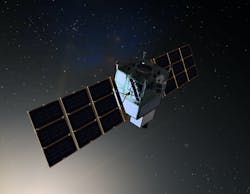Western Digital to develop next-generation radiation-hardened non-volatile memory chips for use in space
KIRTLAND AIR FORCE BASE, N.M. – U.S. Space Force spacecraft experts needed next-generation radiation-hardened non-volatile memory chips for future military applications in space. They found their solution from Western Digital Corp. in San Jose, Calif.
Officials of the U.S. Air Force Research Laboratory's Space Vehicles Directorate at Kirtland Air Force Base, N.M., announced a $35 million contract to Western Digital on Thursday for the Advanced Next Generation Strategic Radiation hardened Memory (ANGSTRM) project.
ANGSTRM seeks to develop a strategic rad-hard non-volatile memory device with near-commercial state-of-the-art performance by using advanced packaging and radiation-hardening techniques with state-of-the-art commercial technology for space and strategic systems.
Advancing strategic rad-hard non-volatile memory technologies is critical to support strategic missiles, missile defense, and military space systems, researchers say. Non-volatile memory devices retain their data even when they lose power.
Related: The quest for commercial-performance electronics in space
The U.S. military uses strategic rad-hard non-volatile memory across many space programs and strategic systems that must withstand the effects of naturally occurring radiation in space, as well as radiation from nuclear explosions.
Ideally, the military would have access to non-volatile memories with the performance and density of commercial state-of-the-art devices; unfortunately today's commercial technologies are not able to withstand the radiation and thermal environments where the military deploys systems. Many military systems, moreover, must use trusted on-shore electronics manufacturing.
Today's rad-hard non-volatile memory technologies are limited in performance and density, so system designers require several devices to meet on-board storage requirements, which drives the size, weight, power, and cost (SwAP-C) of system storage.
The U.S. Space Force researchers are interested in combining radiation hardening to state-of-the-art CMOS and memory technologies to scale density beyond the levels of a single chip, and create qualified strategic rad-hard non-volatile memory for use across military space and strategic systems.
Related: The evolving world of radiation-hardened electronics for space
A multi-phased development approach is necessary to assess the scalability of these technologies while still meeting the radiation requirements for the space and strategic environments.
Researchers want Western Digital to develop rad-hard memories with monolithic memory densities of 4 to 16 gigabits, and with multichip module densities of 32 to 128 gigabits that will last without refresh for 10 to 15 years.
Memory devices should operate with no more than 10 milliwatts of power, with 1 milliwatt performance preferred. Total standby power requirements are no more than 10 milliwatts, and as little as 10 milliwatts. These devices should operate in temperatures from -40 to 125 degrees Celsius, and eventually down to temperatures of -55 C.
Resistance to total-ionizing-dose radiation should be as low as 300 kilorads, and as high as 1,000 kilorads, with fewer than 10 to 12 single-event upset errors per bit day. Single-event latchup resistance should be more than 72 MeV-Cm2/mg, with single-event gate and dielectric rupture of 72 to 100 MeV-Cm2/mg.
Ultimately, the ANGSTRM project seeks to develop a full-scale prototype device, provide device characterization and radiation test reports, and provide a qualification plan with a path to achieve a QML-standard product.
On this contract, Western Digital will do the work in San Jose, Calif., and should be finished by November 2028. For more information contact Western Digital online at www.westerndigital.com, or the Air Force Research Laboratory Space Vehicles Directorate at www.afrl.af.mil/RV.
